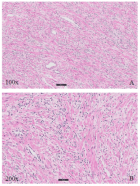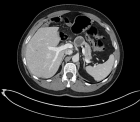Abstract
Research Article
3D software reconstruction for planning robotic assisted radical nephrectomy with level III caval thrombus
Marcos Tobias-Machado*, Ricardo JF de Bragança, Rafael Tourinho-Barbosa, Hamilton C Zampolli and Aurus M Dourado
Published: 30 April, 2020 | Volume 4 - Issue 1 | Pages: 029-033
Inferior vena cava (IVC) involvement by intraluminal extension of tumor is infrequent, occuring in 4% to 10% of patients with renal cell carcinoma (RCC) [1-5]. Based on the cephalic extension of the thrombus, Mayo [6] described a classification of inferior vena cava thrombi in 4 categories, which has implications on surgical complexity, estimated blood loss (EBL) and peri-operative complications, but not cancer-specific survival [2,7]. Level III IVC thrombus is classified as being located in the retro-hepatic IVC below the diaphragm. Total resection of this tumor is the best chance of cure when no distant metastases are present [4,8]. Actually, open radical nephrectomy with concomitant thrombectomy is still the standard treatment. This procedure is technically challenging and involves a large incision and prolonged convalescence [9]. Recently, the feasibility of robotic IVC thrombectomy has been demonstrated, with potential lower EBL and shorter hospitalization and convalescence [7,10-14]. This surgery requires thorough knowledge of surgical anatomy, detailed pre-operative preparation and meticulous robotic technique [7]. The key point in the surgical management is the correct assessment of the extension of the endocaval thrombus, what is mainly based on radiological examinations [8]. Although Ultrasonography (US) and computerized tomography (CT) are useful in demonstrating the extent of the thrombus, CT is not always accurate in delineating the superior margin of the tumor in the IVC. More precisely, magnetic resonance imaging (MRI) can demonstrate a tumor thrombus and its extension, besides signs of wall invasion, being extremely useful to surgical procedure planning [8,15]. Vena cavography is not additive to US, CT, and MRI, and it increases the risk of contrast-associated renal injury [4,8]. However, new modern image technologies has emerged to help surgical planning, as three-dimensional visualization technique (3DVT) based on routine CT or MRI processed image data [16-20]. Recently, a comparative study showed advantage of 3DVT in management of complex renal tumor during laparoscopic partial nephrectomy [20]. This modality is able to demonstrate anatomy relations, allowing the surgeon to observe the relationship between targeted tumor and peripheral structure before surgery and perform virtual manipulation. This kind of preoperative accurate assessment can enhance surgeons confidence of surgical procedure and decrease surgical risk and incidence of complications [20]. There is no report in the literature of the use of this type of technology in cases of IVC tumor thrombus.
We present the use of 3D holographic interactive reconstruction in a single case of robotic radical nephrectomy with level III IVC thrombectomy.
Read Full Article HTML DOI: 10.29328/journal.acst.1001019 Cite this Article Read Full Article PDF
References
- Marshall FF, Dietrick DD, Baumgartner WA, Reitz BA. Surgical management of renal cell carcinoma with intracaval neoplastic extension above the hepatic veins. J Urol. 1988; 139: 1166. PubMed: https://www.ncbi.nlm.nih.gov/pubmed/3373579
- Blute ML, Leibovich BC, Lohse CM, Cheville JC, Zincke H. The Mayo Clinic experience with surgical management, complications and outcome for patients with renal cell carcinoma and venous tumour thrombus. BJU Int. 2004; 94: 33–41. PubMed: https://www.ncbi.nlm.nih.gov/pubmed/15217427
- O’Donohoe MK, Flanagan F, Fitzpatrick JM, Smith JM. Surgical approach to inferior vena caval extension of renal cell carcinoma. Br J Urol. 1987; 60: 492–496.
- Hatcher PA, Anderson EE, Paulson DF, Carson CC, Robertson JE. Surgical management and prognosis of renal cell carcinoma invading the vena cava. J Urol. 1991; 145: 20 – 24. PubMed: https://www.ncbi.nlm.nih.gov/pubmed/1984092
- Al Otaibi M, Abou Youssif T, Alkhaldi A, Sircar K, Kassouf W, et a.. Renal cell carcinoma with inferior vena caval extension: impact of tumour extent on surgical outcome. BJU Int. 2009; 104: 1467–1470. PubMed: https://www.ncbi.nlm.nih.gov/pubmed/19388993
- Neves RJ, Zincke H. Surgical treatment of renal cancer with vena cava extension. Br J Urol. 1987; 59: 390–395. PubMed: https://www.ncbi.nlm.nih.gov/pubmed/3594097
- Gill IS, Metcalfe C, Abreu A, Duddalwar V, Chopra S, et al. Robotic Level III Inferior Vena Cava Tumor Thrombectomy: Initial Series. J Urol. 194: 929-938. PubMed: https://www.ncbi.nlm.nih.gov/pubmed/25858419
- Kaplan S, Ekici S, Dogan R, Demircin M, Özen H, et al. Surgical management of renal cell carcinoma with inferior vena cava tumor thrombus. Am J Surg.2002; 183: 292–299. PubMed: https://www.ncbi.nlm.nih.gov/pubmed/11943130
- Varkarakis IM, Bhayani SB, Allaf ME, Inagaki T, Gonzalgo ML, et al. Laparoscopic-assisted nephrectomy with inferior vena cava tumor thrombectomy: preliminary results. Urology. 2004; 64: 925–929. PubMed: https://www.ncbi.nlm.nih.gov/pubmed/15533479
- Bratslavsky G, Cheng JS. The First Report of Robotic Assisted Radical Nephrectomy with Retrohepatic Vena Caval Tumor Thrombectomy (Level III) Combined with Extended Retroperitoneal Lymph Node Dissection. Urology. 2015; 86: 1235-1240. PubMed: https://www.ncbi.nlm.nih.gov/pubmed/26254172
- Abaza R. Initial series of robotic radical nephrectomy with vena caval tumor thrombectomy. Eur Urol. 2011; 59: 652-656. PubMed: https://www.ncbi.nlm.nih.gov/pubmed/20846783
- Abaza R, Shabsigh A, Castle E, Allaf M, Hu JC, et al. Multi-Institutional Experience with Robotic Nephrectomy with Inferior Vena Cava Tumor Thrombectomy. J Urol. 2016; 195: 865-871. PubMed: https://www.ncbi.nlm.nih.gov/pubmed/26602891
- Wang B, Li H, Ma X, Zhang X, Gu L, et al. Robot-assisted Laparoscopic Inferior Vena Cava Thrombectomy: Different Sides Require Different Techniques. Eur Urol. 2016; 69: 1112-1119. PubMed: https://www.ncbi.nlm.nih.gov/pubmed/26706105
- Chopra S, Simone G, Metcalfe C, de Castro Abreu AL, Nabhani J, et al. Robot-assisted Level II-III Inferior Vena Cava Tumor Thrombectomy: Step-by-Step Technique and 1-Year Outcomes. Eur Urol. 2017; 72: 267-274. PubMed: https://www.ncbi.nlm.nih.gov/pubmed/27663048
- Myneni L, Hricak H, Carroll PR. Magnetic resonance imaging of renal carcinoma with extension into the vena cava: staging, occuracy and recent advances. Br J Urol. 1991; 68: 571–578. PubMed: https://www.ncbi.nlm.nih.gov/pubmed/1773285
- Wang D, Zhang B, Yuan X, Zhang X, Liu C. Preoperative planning and real-time assisted navigation by three- dimensional individual digital model in partial nephrec- tomy with three-dimensional laparoscopic system. Int J Comput Assist Radiol Surg. 2015; 10: 1461–1468. PubMed: https://www.ncbi.nlm.nih.gov/pubmed/25577366
- Komai Y, Sakai Y, Gotohda N, Kobayashi T, Kawakami S, et al. A novel 3-dimensional image analysis system for case-specific kidney anatomy and surgical simulation to facilitate clampless partial nephrectomy. Urology. 2014; 83: 500–506. PubMed: https://www.ncbi.nlm.nih.gov/pubmed/24468517
- Chen Y, Li H, Wu D, Bi K, Liu C. Surgical planning and manual image fusion based on 3D model facilitate laparoscopic partial nephrectomy for intrarenal tumors. World J Urol. 2014; 32: 1493–1499. PubMed: https://www.ncbi.nlm.nih.gov/pubmed/24337151
- Lasser MS, Doscher M, Keehn A, Chernyak V, Garfein E, et al. Virtual surgical planning: A novel aid to robot-assisted laparoscopic partial nephrectomy. J Endourol. 2012; 26: 1372–1379. PubMed: https://www.ncbi.nlm.nih.gov/pubmed/22642371
- Wang Z, Qi L, Yuan P, Zu X, Chen W, et al. Application of Thee-dimensional visualization technology in laparoscopi partial nephrectomy of renal tumor: A comparative study. J Laparoendosc Adv Surg Tech A. 2017: 27: 516-523. PubMed: https://www.ncbi.nlm.nih.gov/pubmed/28186431
- Kearnes RJ, Blute ML. Surgery insight: management of renal cell carcinoma with associated inferior vena cava thrombus. Nat Clin Pract Urol. 2008; 5: 329–339. PubMed: https://www.ncbi.nlm.nih.gov/pubmed/18477994
- Patil MB, Montez J, Loh-Doyle J, Cai J, Skinner EC, et al. Level III-IV inferior vena caval thrombectomy without cardiopulmonary bypass: Long-term experience with intrapericardial control. J Urol. 2014; 192: 682-689. PubMed: https://www.ncbi.nlm.nih.gov/pubmed/24704114
- Ramirez D, Maurice MJ, Cohen B, Krishnamurthi V, Haber GP. Robotic level III IVC tumor thrombectomy: duplicating the open approach. Urology. 2016; 90: 204-207. PubMed: https://www.ncbi.nlm.nih.gov/pubmed/26802799
Figures:

Figure 1

Figure 2

Figure 3

Figure 4

Figure 5
Similar Articles
-
Theranostics: A Unique Concept to Nuclear MedicineLucio Mango*. Theranostics: A Unique Concept to Nuclear Medicine. . 2017 doi: 10.29328/journal.acst.1001001; 1: 001-004
-
Predictors of Candidemia infections and its associated risk of mortality among adult and pediatric cancer patients: A retrospective study in Lahore, Punjab, PakistanHafiz Muhammad Bilal*,Neelam Iqbal,Shazia Ayaz. Predictors of Candidemia infections and its associated risk of mortality among adult and pediatric cancer patients: A retrospective study in Lahore, Punjab, Pakistan. . 2018 doi: 10.29328/journal.acst.1001003; 2: 001-007
-
Endogenus toxicology: Modern physio-pathological aspects and relationship with new therapeutic strategies. An integrative discipline incorporating concepts from different research discipline like Biochemistry, Pharmacology and ToxicologyLuisetto M*,Naseer Almukhtar,Behzad Nili Ahmadabadi,Gamal Abdul Hamid,Ghulam Rasool Mashori,Kausar Rehman Khan,Farhan Ahmad Khan,Luca Cabianca. Endogenus toxicology: Modern physio-pathological aspects and relationship with new therapeutic strategies. An integrative discipline incorporating concepts from different research discipline like Biochemistry, Pharmacology and Toxicology . . 2019 doi: 10.29328/journal.acst.1001004; 3: 001-024
-
Insilico investigation of TNFSF10 signaling cascade in ovarian serous cystadenocarcinomaAsima Tayyeb*,Zafar Abbas Shah. Insilico investigation of TNFSF10 signaling cascade in ovarian serous cystadenocarcinoma. . 2019 doi: 10.29328/journal.acst.1001005; 3: 025-034
-
Fifth “dark” force completely change our understanding of the universeRobert Skopec*. Fifth “dark” force completely change our understanding of the universe. . 2019 doi: 10.29328/journal.acst.1001006; 3: 035-041
-
Risk factors of survival in breast cancerAkram Yazdani*. Risk factors of survival in breast cancer. . 2019 doi: 10.29328/journal.acst.1001007; 3: 042-044
-
Results of chemotherapy in the treatment of chronic lymphoid leukemia in Black Africa: Experience of Côte d’IvoirePacko Dieu-le-veut Saint-Cyr Sylvestre*,N’dhatz Comoe Emeraude,Kamara Ismael,Boidy Kouakou,Koffi Kouassi Gustave,Nanho Danho Clotaire,Koffi Kouassi Gustave. Results of chemotherapy in the treatment of chronic lymphoid leukemia in Black Africa: Experience of Côte d’Ivoire. . 2019 doi: 10.29328/journal.acst.1001008; 3: 045-048
-
Stercoral perforation: A rare case and reviewLava Krishna Kannappa*,Muhammad Sufian Khalid,May Hnin Lwin Ko,Mohsin Hussein,Jia Hui Choong,Ameer Omar Rawal-Pangarkar,Danaradja Armugam,Yahya Salama. Stercoral perforation: A rare case and review. . 2019 doi: 10.29328/journal.acst.1001009; 3: 049-051
-
Different optimization strategies for the optimal control of tumor growthAbd El Moniem NK*,Sweilam NH,Tharwat AA. Different optimization strategies for the optimal control of tumor growth. . 2019 doi: 10.29328/journal.acst.1001010; 3: 052-062
-
Risk factor of liver metastases in breast cancerAkram Yazdani*. Risk factor of liver metastases in breast cancer. . 2019 doi: 10.29328/journal.acst.1001011; 3: 063-065
Recently Viewed
-
Incidence of hypertension in a high-risk workgroup (Police officers) - Observational studyGuillermo Padrón Arredondo*. Incidence of hypertension in a high-risk workgroup (Police officers) - Observational study. Ann Clin Hypertens. 2019: doi: 10.29328/journal.ach.1001020; 3: 052-058
-
The Role of Mitochondria in Chronic Wound Healing (Mitotherapy): Signaling and Therapeutic ImplicationsSeyedeh Sara Azadeh*,Hoda Keshmiri Neghab. The Role of Mitochondria in Chronic Wound Healing (Mitotherapy): Signaling and Therapeutic Implications. Arch Biotechnol Biomed. 2025: doi: 10.29328/journal.abb.1001043; 9: 001-009
-
Progresses of the Badminton equipment relate to exercise: Some training aspectsZhi Qiang Liang,Jian She Li*. Progresses of the Badminton equipment relate to exercise: Some training aspects. J Sports Med Ther. 2018: doi: 10.29328/journal.jsmt.1001020; 3: 001-009
-
Effects of a short Cardiovascular Rehabilitation program in Hypertensive subjects: A Pilot StudyJuliana Bassalobre Carvalho Borges,Débora Tazinaffo Bueno,Monique Fernandes Peres,Ana Paula Aparecida Mantuani,Andréia Maria Silva,Giovane Galdino*. Effects of a short Cardiovascular Rehabilitation program in Hypertensive subjects: A Pilot Study. J Sports Med Ther. 2017: doi: 10.29328/journal.jsmt.1001008; 2: 051-056
-
Shoulder muscle weakness effects on muscle hardness around the shoulder joint and scapulaeKubota Atsushi*,Takayanagi Chiho,Kishimoto Kohei. Shoulder muscle weakness effects on muscle hardness around the shoulder joint and scapulae. J Sports Med Ther. 2020: doi: 10.29328/journal.jsmt.1001049; 5: 001-007
Most Viewed
-
Evaluation of Biostimulants Based on Recovered Protein Hydrolysates from Animal By-products as Plant Growth EnhancersH Pérez-Aguilar*, M Lacruz-Asaro, F Arán-Ais. Evaluation of Biostimulants Based on Recovered Protein Hydrolysates from Animal By-products as Plant Growth Enhancers. J Plant Sci Phytopathol. 2023 doi: 10.29328/journal.jpsp.1001104; 7: 042-047
-
Sinonasal Myxoma Extending into the Orbit in a 4-Year Old: A Case PresentationJulian A Purrinos*, Ramzi Younis. Sinonasal Myxoma Extending into the Orbit in a 4-Year Old: A Case Presentation. Arch Case Rep. 2024 doi: 10.29328/journal.acr.1001099; 8: 075-077
-
Feasibility study of magnetic sensing for detecting single-neuron action potentialsDenis Tonini,Kai Wu,Renata Saha,Jian-Ping Wang*. Feasibility study of magnetic sensing for detecting single-neuron action potentials. Ann Biomed Sci Eng. 2022 doi: 10.29328/journal.abse.1001018; 6: 019-029
-
Pediatric Dysgerminoma: Unveiling a Rare Ovarian TumorFaten Limaiem*, Khalil Saffar, Ahmed Halouani. Pediatric Dysgerminoma: Unveiling a Rare Ovarian Tumor. Arch Case Rep. 2024 doi: 10.29328/journal.acr.1001087; 8: 010-013
-
Physical activity can change the physiological and psychological circumstances during COVID-19 pandemic: A narrative reviewKhashayar Maroufi*. Physical activity can change the physiological and psychological circumstances during COVID-19 pandemic: A narrative review. J Sports Med Ther. 2021 doi: 10.29328/journal.jsmt.1001051; 6: 001-007

HSPI: We're glad you're here. Please click "create a new Query" if you are a new visitor to our website and need further information from us.
If you are already a member of our network and need to keep track of any developments regarding a question you have already submitted, click "take me to my Query."




















































































































































